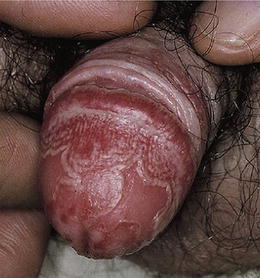Fig. 17.1
Reactive arthritis – comparison of psoriasis (a) and reactive arthritis syndrome (B, balanitis circinata) involving the glans penis. Note the highly characteristic coalescence of lesions in this case of reactive arthritis (formerly called Reiter’s syndrome) forming a wavy pattern (arrow) (Reprinted from Habif TP. Clinical Dermatology, 4th edition. Edinburgh, UK: Mosby; 2003. With permission from Elsevier)

Fig. 17.2
Reactive arthritis – classic serpiginous pattern of circinate balanitis (Reprinted from Wu IB, Schwartz RA. Reiter’s syndrome: The classic triad and more. J Am Acad Dermatol 2008; 59:113–121. With permission from Elsevier)
Women too may demonstrate genital lesions as a manifestation of ReA in the form of circinate vulvitis and ulcerative vulvitis. Although ulcerative vulvitis is far less common than circinate balanitis, the lesions are themselves similar in appearance with red, crusted plaques on the vulva and perineum. There may be papules on the vulva, labia minora, and vestibule as well as scattered, demarcated, shallow erosions over the entire genital area.
Differential Diagnosis
Recognizing the genital lesions of ReA is made easier by performing a thorough examination looking for other dermatologic manifestations of ReA. In addition to circinate balanitis, the affected patient may demonstrate keratoderma blennorrhagicum (see chapter “Skin Manifestations of Neonatal Lupus Erythematosus”), nail changes, and painless oral lesions.
In addition to the cutaneous lesion, the penis may demonstrate a bland urethritis – often mistakenly thought to be an STD discharge – that develops after the initial inciting infection, whether the inciting infection was an STD or enteric infection. Urethritis and cervicitis may occur in women, while prostatitis may occur in men.
Stay updated, free articles. Join our Telegram channel

Full access? Get Clinical Tree








